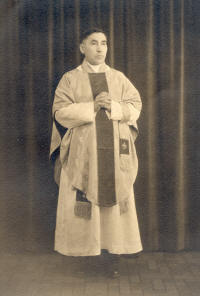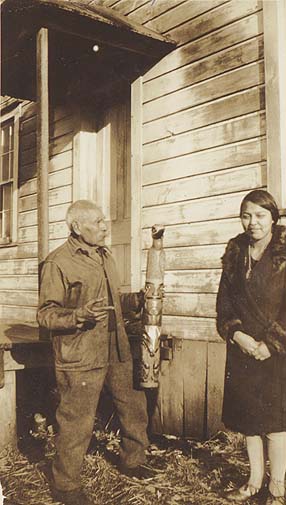Another Metlakatlan carver was Clyde Boyd: photo not available; he was born in Tenakee in September 1924; married Frieda Milne and lived in Metlakatla with her father Silas Milne in 1948-50; worked in construction in Ketchikan, where he died in 1976. Probably learned carving from his step-father, Robert Jones. see one of his carvings. His son, Clyde Boyd Jr. is still carving the "good luck" totems in Metlakatla today. |
New Metlakatla was founded in 1887 by a lay minister, William Duncan, and a flock of around 830 Tshimsian who followed him from their homes in Canada. They came to live in Tlingit lands, having left their old culture behind, and during the journey a stop was made to burn masks and artifacts. Duncan also burned many Tlingit poles which he found at the site of New Metlakatla, which was still in use as a Tlingit Winter camp when he found it "abandoned." As a result, there was a lack of models for carvers to copy, and of course carving, like other native practices, was frowned upon (Alaska had not enacted "Potlatch laws" like those that formally banned native practices in Canada, but Duncan had announced similar rules from the pulpit). The carving of house-posts, dance screens, and ceremonial objects, with its sohisticated form-line system, which the Tsimshian had been famous for, was no more. In this climate, a distinctive style of totem carving originated. Because they were not done on a grand scale or for ceremonial purposes, these tiny souvenir totems apparently escaped censure; Duncan also apparently encouraged native crafts as long as the purpose was commercial and not religious (see McDonald). Duncan was well aware of the difference, as he had been instrumental in collecting important native ceremonial items, such as the famous "stone mask," the sighted one of the pair, which he had been the first white man to own. Models of the real totems in Ketchikan were a common subject for the early carvers, but a new totem also appeared in Metlakatla: the eagle-salmon-bear totem that Eli Tait called the "good luck" or "friendship totem." Carved nowhere else, this style totem is somewhat of a mystery; it is not known whether it was copied from a full-size original, or invented by one of the Metlakatlan carvers. I do have some theories as to origin, and the meaning and story of the figures is now known; but many questions about the totem poles and their carvers remain to be answered. See the biography index and site map for more details. |
I know very little about the lives of the Metlakatla carvers; please contact me if you are a relative or know any details of their lives, or if there are any carvers in your family, or if you know the answers to any of these other questions..... I hope to post more infomation on Metlakatla carvers soon. |
born 1837, Metlakatla BC; baptized 1-10-1875; married 1883; a fisherman and carver, he died in 1934. Native name Neashloot, of the Kinnchtawiks band. |
Eli Tait ("Crippled Tsimshian Carver, 1923(?)," Viola Garfield, UW archives (I've seen a clearer version, and believe the calendar may be from 1934 or 1936) |

Eli Tait ("Crippled Tsimshian Carver, 1923(?)," Viola Garfield, UW archives (I've seen a clearer version, and believe the calendar may be from 1934 or 1936) |

born 1837, Metlakatla BC; baptized 1-10-1875; married 1883; a fisherman and carver, he died in 1934. Native name Neashloot, of the Kinnchtawiks band. |

I know very little about the lives of the Metlakatla carvers; please contact me if you are a relative or know any details of their lives, or if there are any carvers in your family, or if you know the answers to any of these other questions..... I hope to post more infomation on Metlakatla carvers soon. |

last updated on: December 24, 2005
Early Totem Carvers of New Metlakatla |

Rev. Paul Mather |
Rev. Paul Mather, first Native deacon in 1927 and priest in 1932 from Southeast Alaska. Served St. Elizabeth's for 15 years. Born August 11, 1878; Died in January 1942. (It is said he also carved, but I haven't seen any signed totems attributed to him). Two of his sons were carvers; Conrad Mather and George Mather Sr. In the 1930's Paul Mather tried to teach native singing to the elementary school children, and received a lot of criticism as a result. |
1876-1972 |
These poles by Sydney Campbell are very interesting; the larger two display the same four figures, in different order; they are variants or combinations of the "good luck totem" with other figures possibly taken from Chief Kian's and Johnson's totems--owl and wolf. The speckled bear here holds a fish. |
New Metlakatla was founded in 1887 by a lay minister, William Duncan, and a flock of around 830 Tshimsian who followed him from their homes in Canada. They came to live in Tlingit lands, having left their old culture behind, and during the journey a stop was made to burn masks and artifacts. Duncan also burned many Tlingit poles which he found at the site of New Metlakatla, which was still in use as a Tlingit Winter camp when he found it "abandoned." As a result, there was a lack of models for carvers to copy, and of course carving, like other native practices, was frowned upon (Alaska had not enacted "Potlatch laws" like those that formally banned native practices in Canada, but Duncan had announced similar rules from the pulpit). The carving of house-posts, dance screens, and ceremonial objects, with its sohisticated form-line system, which the Tsimshian had been famous for, was no more. In this climate, a distinctive style of totem carving originated. Because they were not done on a grand scale or for ceremonial purposes, these tiny souvenir totems apparently escaped censure; Duncan also apparently encouraged native crafts as long as the purpose was commercial and not religious (see McDonald). Duncan was well aware of the difference, as he had been instrumental in collecting important native ceremonial items, such as the famous "stone mask," the sighted one of the pair, which he had been the first white man to own. Models of the real totems in Ketchikan were a common subject for the early carvers, but a new totem also appeared in Metlakatla: the eagle-salmon-bear totem that Eli Tait called the "good luck" or "friendship totem." Carved nowhere else, this style totem is somewhat of a mystery; it is not known whether it was copied from a full-size original, or invented by one of the Metlakatlan carvers. I do have some theories as to origin, and the meaning and story of the figures is now known; but many questions about the totem poles and their carvers remain to be answered. See the biography index and site map for more details. |
Another Metlakatlan carver was Clyde Boyd: photo not available; he was born in Tenakee in September 1924; married Frieda Milne and lived in Metlakatla with her father Silas Milne in 1948-50; worked in construction in Ketchikan, where he died in 1976. Probably learned carving from his step-father, Robert Jones. see one of his carvings. His son, Clyde Boyd Jr. is still carving the "good luck" totems in Metlakatla today. |

Sydney Campbell in 1923, with totem pole and Josephine Henson (Hewson?) Hayward. Campbell may have been a neighbor of Eli Tait, as Campbell's entry in the 1930 census is immediately after Tait's. Campbell, 80 years old at the time, listed his occupation as a carver of totem poles. |
In 1929 |